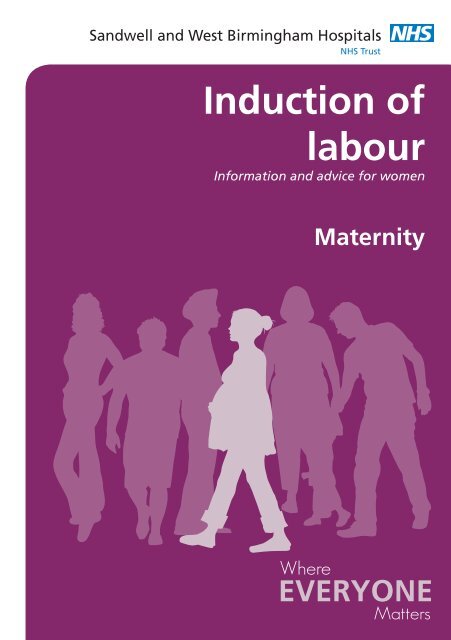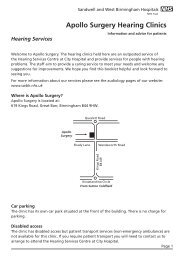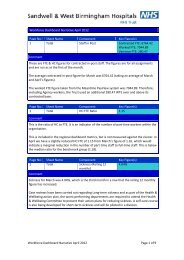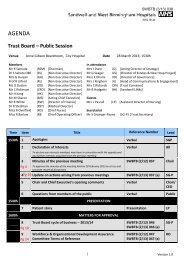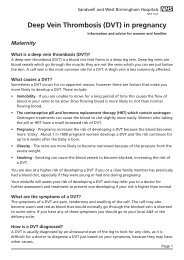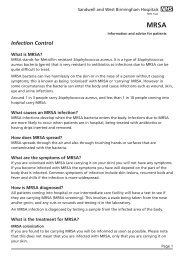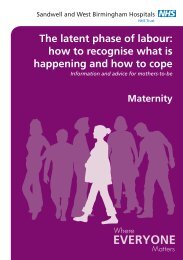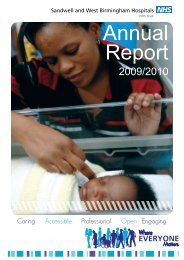Induction of labour - Sandwell & West Birmingham Hospitals
Induction of labour - Sandwell & West Birmingham Hospitals
Induction of labour - Sandwell & West Birmingham Hospitals
Create successful ePaper yourself
Turn your PDF publications into a flip-book with our unique Google optimized e-Paper software.
<strong>Induction</strong> <strong>of</strong><br />
<strong>labour</strong><br />
Information and advice for women<br />
Maternity
What is induction <strong>of</strong> <strong>labour</strong>?<br />
<strong>Induction</strong> <strong>of</strong> <strong>labour</strong> (IOL) is a process designed to start <strong>labour</strong><br />
artificially. Around 1 in 5 <strong>labour</strong>s are started artificially using<br />
induction.<br />
In most pregnancies <strong>labour</strong> starts naturally between 37 and 42<br />
weeks but in some women pregnancy continues beyond this time.<br />
Women who have low risk pregnancies will be <strong>of</strong>fered an induction<br />
<strong>of</strong> <strong>labour</strong> at 42 weeks <strong>of</strong> pregnancy.<br />
What are the benefits <strong>of</strong> induction <strong>of</strong> <strong>labour</strong>?<br />
• If your pregnancy is uncomplicated, having your <strong>labour</strong> induced<br />
after 41 weeks <strong>of</strong> pregnancy reduces your chance <strong>of</strong> having a<br />
stillbirth. The risk <strong>of</strong> stillbirth is:<br />
- 1 – 2 babies in 3000 at 39 weeks<br />
- 3 babies in 3000 at 40 weeks<br />
- 4 babies in 3000 at 41 weeks<br />
- 5 babies in 3000 at 42 weeks<br />
- 6 babies in 3000 at 43 weeks<br />
• It also reduces the risk <strong>of</strong> your baby opening their bowels and<br />
passing their first poo (meconium) whilst in the womb, as this is<br />
more likely to occur the longer a pregnancy continues.<br />
• If your pregnancy continues after your due date, inducing your<br />
<strong>labour</strong> so that you can give birth to your baby will end the<br />
discomfort <strong>of</strong> being heavily pregnant.<br />
• If there is a risk to you or your baby’s health, your doctor/<br />
midwife may advise you to have your <strong>labour</strong> induced early as this<br />
is safer for you/your baby.<br />
• If your waters have broken but after 48 hours your <strong>labour</strong> still<br />
hasn’t started, inducing your <strong>labour</strong> so that your baby can be born<br />
reduces the risk <strong>of</strong> you and your baby developing an infection.<br />
2
What are the risks and disadvantages <strong>of</strong> induction <strong>of</strong><br />
<strong>labour</strong>?<br />
• You will need more internal examinations during <strong>labour</strong><br />
(average <strong>of</strong> 3 extra examinations compared to normal <strong>labour</strong>).<br />
• Labour can be more painful if it has been induced and more<br />
women need an epidural. This is because your <strong>labour</strong> is started<br />
artificially instead <strong>of</strong> the natural gentle way.<br />
• <strong>Induction</strong> increases the chances <strong>of</strong> you needing an assisted<br />
vaginal delivery such as forceps delivery, or a caesarean section.<br />
15 out <strong>of</strong> 100 women who have their <strong>labour</strong> induced will need<br />
an assisted vaginal delivery, and 22 out <strong>of</strong> 100 will need a<br />
caesarean section.<br />
• There is a risk that the induction will not work. If this is the case<br />
you will be reviewed the next day by a consultant who may<br />
advise a further attempt at induction or a caesarean section.<br />
• There is a risk that inducing <strong>labour</strong> with medications<br />
(prostaglandins and oxytocin) could cause your womb to contract<br />
too quickly, which could affect the baby’s heart rate. This may<br />
mean you need medication to relax your womb, or the induction<br />
medication stopped.<br />
Are there any alternatives to having my <strong>labour</strong> induced?<br />
An alternative to having your <strong>labour</strong> induced is to wait for it to start<br />
naturally.<br />
What are the risks <strong>of</strong> not having induction <strong>of</strong> <strong>labour</strong>?<br />
If you decide not to have your <strong>labour</strong> induced and wait for your<br />
<strong>labour</strong> to start naturally there is a small increase in the risk that your<br />
baby will be stillborn. Because <strong>of</strong> this risk we will monitor your baby<br />
3
carefully so that any problems can be identified. This will involve the<br />
following:<br />
• Having an ultrasound scan at 14 days over your due date to<br />
check the amount <strong>of</strong> water around your baby and the blood<br />
flow to the baby from the placenta.<br />
• Checking your baby’s heart beat at 14 days over your due date.<br />
• Monitoring your baby twice a week until you go into <strong>labour</strong>.<br />
Before you are <strong>of</strong>fered an induction <strong>of</strong> <strong>labour</strong><br />
When you are 40 weeks pregnant you will be assessed by your<br />
midwife and will be <strong>of</strong>fered a membrane sweep. This involves your<br />
midwife placing their finger inside the neck <strong>of</strong> your womb and<br />
making a sweeping movement to separate the membranes that<br />
surround your baby from your cervix (see the leaflet ‘Membrane<br />
sweep’ for more information). Your community midwife will<br />
arrange to do this either in clinic or at your home.<br />
Membrane sweeping has been shown to increase the chances <strong>of</strong><br />
<strong>labour</strong> starting naturally within the next 48 hours, especially if<br />
you have more than one. If you are having a vaginal birth after<br />
caesarean section it is important that you consider having this<br />
procedure to maximise your chance <strong>of</strong> going into <strong>labour</strong> naturally.<br />
If a membrane sweep is successful in starting <strong>labour</strong> and your<br />
pregnancy is ‘low risk’, you will still be able to give birth in one <strong>of</strong><br />
our birth centres or at home.<br />
If you do not go into <strong>labour</strong> within the next 48 hours you will be<br />
<strong>of</strong>fered an induction <strong>of</strong> your <strong>labour</strong>. If your pregnancy is ‘low risk’<br />
your <strong>labour</strong> will be induced by 14 days after your expected due<br />
date. If your <strong>labour</strong> is induced you will not be able to give birth at<br />
home or in one <strong>of</strong> our birth centres – you will need to have your<br />
baby on the delivery suite at City Hospital.<br />
4
Your midwife will give you a date to come in for your induction.<br />
You will then need to call the delivery suite the day before your<br />
induction to check that it is still ok for you to come in, and what<br />
time you should arrive at.<br />
How will my <strong>labour</strong> be induced?<br />
There are different methods <strong>of</strong> inducing <strong>labour</strong> and you may be<br />
<strong>of</strong>fered one or all <strong>of</strong> the methods depending on your circumstances.<br />
Prostaglandins<br />
Prostaglandins are hormones that s<strong>of</strong>ten, shorten and open<br />
the neck <strong>of</strong> the womb (cervix) and cause the womb to contract.<br />
Prostaglandins are given in a pessary (tampon) which is inserted<br />
behind the cervix. The prostaglandin pessary we use is called<br />
Propess.<br />
Your baby’s heartbeat will be monitored before and after the<br />
pessary is given so you will need to stay in bed for a little while so<br />
this can be done.<br />
When your cervix is open, your waters can be broken.<br />
Oxytocin (Syntocinon)<br />
Oxytocin is a hormone, similar to the one produced naturally by<br />
your body, which encourages regular and strong contractions. It is<br />
given through a ‘drip’ into a vein in your arm. Once the oxytocin<br />
has been given your contractions and your baby’s heartbeat will be<br />
monitored closely until your baby is born.<br />
Because oxytocin is given through a drip, you won’t be able to move<br />
around as much as with other methods.<br />
Catheter and balloon<br />
If you have had a caesarean section in the past and are planning a<br />
normal vaginal birth, you can be <strong>of</strong>fered induction with a catheter<br />
5
alloon. This involves a catheter (a thin, flexible plastic tube) being<br />
put into your cervix. The catheter has a small balloon at the top <strong>of</strong> it<br />
which is then filled with water to keep the catheter in place. As the<br />
weight <strong>of</strong> the balloon puts pressure on your cervix it starts to open.<br />
We can then break your waters to allow your <strong>labour</strong> to progress.<br />
Amniotomy (breaking your waters)<br />
When the neck <strong>of</strong> your womb has started to open your waters can<br />
be broken; this is called an amniotomy. Breaking your waters makes<br />
your contractions stronger and your <strong>labour</strong> progress more quickly.<br />
Your waters are broken by a midwife or doctor who will insert a<br />
small instrument (similar to a crochet hook) into your vagina and<br />
make a small hole in the sac <strong>of</strong> water (membrane).<br />
Breaking your waters does not cause any harm to you or your baby,<br />
but the vaginal examination needed to perform it can cause some<br />
discomfort.<br />
Who can I speak to if I have more questions?<br />
If you have any questions or concerns about having your <strong>labour</strong><br />
induced please speak to your midwife.<br />
Contact details<br />
Maternity Triage<br />
0121 507 4181<br />
6
Further information<br />
NHS Choices Pregnancy and Baby Guide<br />
www.nhs.uk/planners/pregnancycareplanner<br />
For more information about pregnancy, childbirth and our<br />
maternity services please see the maternity pages <strong>of</strong> our websites<br />
www.swbh.nhs.uk and www.swbhengage.com, follow us on Twitter<br />
@SWBHnhs and like us on Facebook www.facebook.com/SWBHnhs.<br />
Sources used for the information in this leaflet<br />
National Institute for Health and Clinical Excellence, CG70 ‘<strong>Induction</strong><br />
<strong>of</strong> <strong>labour</strong>’, July 2008<br />
7
If you would like to suggest any amendments or improvements to this leaflet<br />
please contact the communications department on 0121 507 5420 or email:<br />
swb-tr.swbh-gm-patient-information@nhs.net<br />
A Teaching Trust <strong>of</strong> The University <strong>of</strong> <strong>Birmingham</strong><br />
Incorporating City, <strong>Sandwell</strong> and Rowley Regis <strong>Hospitals</strong><br />
© <strong>Sandwell</strong> and <strong>West</strong> <strong>Birmingham</strong> <strong>Hospitals</strong> NHS Trust<br />
ML3991<br />
Issue Date: June 2013<br />
Review Date: June 2015


